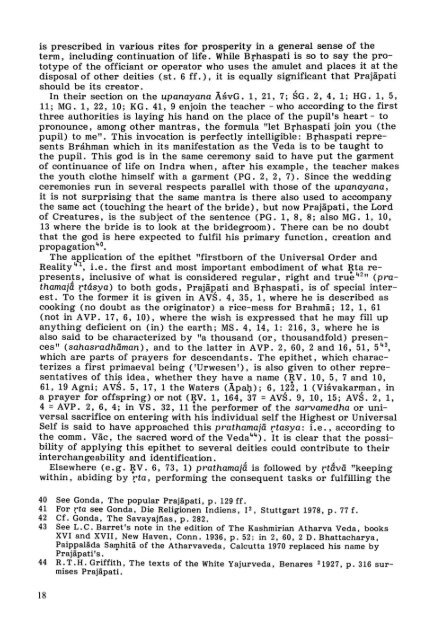Prajapati's relations with Brahman, Brhaspati and Brahma - DWC
Prajapati's relations with Brahman, Brhaspati and Brahma - DWC
Prajapati's relations with Brahman, Brhaspati and Brahma - DWC
Create successful ePaper yourself
Turn your PDF publications into a flip-book with our unique Google optimized e-Paper software.
is prescribed in various rites for prosperity in a general sense of the<br />
term, including continuation of life. While <strong>Brhaspati</strong> is so to say the prototype<br />
of the officiant or operator who uses the amulet <strong>and</strong> places it at the<br />
disposal of other deities (st. 6 ff.), it is equally significant that Prajäpati<br />
should be its creator.<br />
In their section on the upanayana AsvG. 1, 21, 7; SG. 2,4,1; HG. 1, 5,<br />
11; MG. 1, 22, 10; KG. 41, 9 enjoin the teacher - who according to the first<br />
three authorities is laying his h<strong>and</strong> on the place of the pupil's heart - to<br />
pronounce, among other mantras , the formula "let <strong>Brhaspati</strong> join you (the<br />
pupil) to me". This invocation is perfectly intelligible: <strong>Brhaspati</strong> represents<br />
Bráhman which in its manifestation as the Veda is to be taught to<br />
the pupil. This god is in the same · ceremony said to have put the garment<br />
of continuance of life on Indra when, after his example, the teacher makes<br />
the youth clothe himself <strong>with</strong> a garment (PG. 2, 2, 7). Since the wedding<br />
ceremonies run in several respects parallel <strong>with</strong> those of the upanayana,<br />
it is not surprising that the same mantra is there also used to accompany<br />
the same act (touching the heart of the bride), but now Prajäpati, the Lord<br />
of Creatures, is the subject of the sentence (PG. 1, 8, 8; also MG. 1, 10,<br />
13 where the bride is to look at the bridegroom). There can be no doubt<br />
that the god is here expected to fulfil his primary function, creation <strong>and</strong><br />
propagation" o •<br />
The application of the epithet "firstborn of the UniversalOrder <strong>and</strong><br />
Reality"l, i.e. the first <strong>and</strong> most important embodiment of what ~ta represents<br />
, inclusive of what is considered regular, right <strong>and</strong> true "2" (prathamajá<br />
rtásya) to both gods, Prajäp'ati <strong>and</strong> <strong>Brhaspati</strong>, is of special interest.<br />
To the former it is given in A VS. 4, 35, 1, where he is described as<br />
cooking (no doubt as the originator) a rice-mess for Brahmä; 12, 1, 61<br />
(not in AVP. 17, 6, 10), where the wish is expressed that he may fill up<br />
anything deficient on (in) the earth; MS. 4, 14, 1: 216,3, where he is<br />
also said to be characterized by "a thous<strong>and</strong> (or, thous<strong>and</strong>fold) presences"<br />
(sahasradhäman), <strong>and</strong> to thelatter in AVP. 2, 60, 2 <strong>and</strong> 16,51, 5"3,<br />
which are parts of prayers for descendants. The epithet, which characterizes<br />
a first primaeval being ('Urwesen'), is also given to other representatives<br />
of this idea, whether they have a name (RV. 10, 5, 7 <strong>and</strong> 10,<br />
61,19 Agni; AVS. 5, 17, 1 the Waters (Apah); 6,122,1 (Visvakarman, in<br />
a prayer for offspring) or not (~V. 1, 164, 37 = AVS. 9, 10, 15; AVS. 2, 1,<br />
4 = AVP. 2, 6, 4; in VS. 32, 11 the performer of the sarvamedha or universal<br />
sacrifice on entering <strong>with</strong> his individual self the Highest or Universal<br />
Self is said to have approached this prathamajä rtasya: i. e. , according to<br />
the comm. Väc, the sacred word of the Veda .... ). It is clear that the possibility<br />
of applying this epithet to several deities could contribute to their<br />
interchangeability <strong>and</strong> identification.<br />
Elsewhere (e.g. ~V. 6, 73, 1) prathamajá is followed by rtávä "keeping<br />
<strong>with</strong>in, abiding by rta, performing the consequent tasks or fulfilling the<br />
40 See Gonda, The popular Prajäpati, p. 129 ff.<br />
41 For rta see Gonda, Die Religionen Indiens, 12, Stuttgart 1978, p. 77 f.<br />
42 Cf. Gonda, The Savayaji'ias, p. 282.<br />
43 See L. C. Barret 's note in the edition of The Kashmirian Atharva Veda, books<br />
XVI <strong>and</strong> XVII, New Haven, Conn. 1936, p. 52 ; in 2, 60, 2 D. Bhattacharya,<br />
Paippaläda Sarphitä of the Atharvaveda, Calcutta 1970 replaced his name by<br />
Prajäpati's.<br />
44 R. T. H. Griffith , The texts of the White Yajurveda, Benares 21927, p. 316 surmises<br />
Prajäpati.<br />
18
















